PC-12
The latest on PC-12
12 December 2023
04 September 2023
Why the Truck and Engine Manufacturers Association has requested a new heavy-duty engine oil category

Work in North America on the development of the new engine oil category for heavy-duty diesel engines, known as PC-12, is already underway. In this article, Insight explores why the Truck and Engine Manufacturers Association requested the new category, the changes to emissions regulations that are on the cards and when the new category might be ready.
As the world works to improve air quality and to decarbonise, the efforts to limit tailpipe emissions from transportation is intensifying. In North America new emissions regulations are driving changes to heavy-duty diesel vehicles and industry lubricant specifications are evolving to ensure oils continue to offer sufficient protection and performance.
Significant efforts from the Environmental Protection Agency (EPA) and the California Air Resources Board (CARB) are underway to reduce the nitrogen oxides (NOx) and greenhouse gas (GHG) emissions from heavy-duty diesel trucks. The severity of the limits being proposed for 2027 and 2031 will herald significant change to vehicle hardware, which will in turn impact lubricant requirements. These changes, along with the desire to move to lower viscosity oils for fuel economy improvement, prompted the Truck and Engine Manufacturers Association (EMA) to request a new heavy-duty diesel engine oil category development. Their request, which aims to ensure lubricants continue to deliver sufficient engine and aftertreatment protection, was accepted by the American Petroleum Institute (API) at the end of 2021.
EPA is introducing its ‘Clean Trucks Plan’ to cut NOx emissions and set updated GHG emissions standards. At the same time, CARB is introducing ultra-low NOx limits.
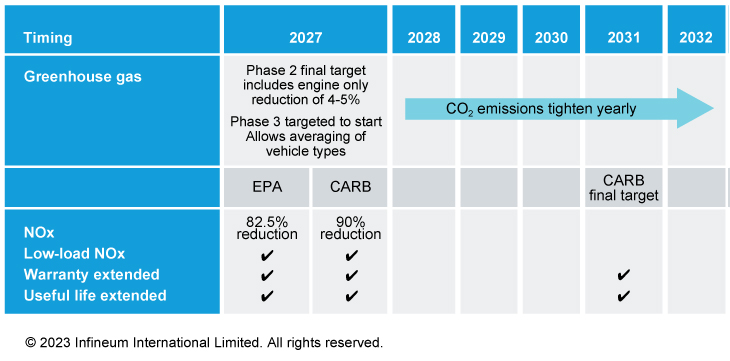
Vehicle warranty in terms of years has been doubled from 5 to 10 while in terms of miles it has risen from 100,000 to 450,000. For current trucks, the useful life for aftertreatment equipment and emissions devices is 435,000 miles. Under the new standards, this useful life will be extended to as much as 800,000 miles.

The reduction of NOx emissions will have the biggest impact on heavy-duty vehicle hardware. EPA will require a reduction from today’s 0.20 g/bhp-hr to 0.035 g/bhp-hr in NOx for on-highway type driving cycles. In addition a new low load cycle parameter with a limit of 0.050 g/bhp-hr has been added to mimic local and stop/start type driving.
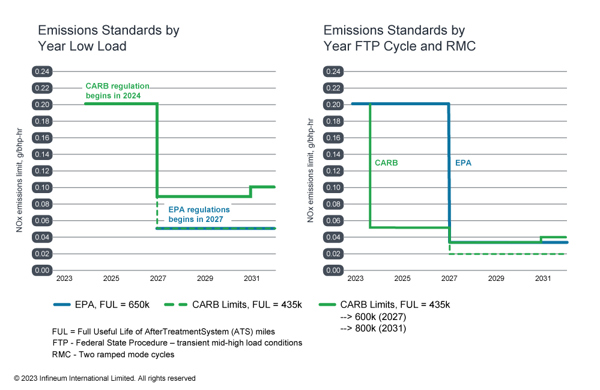
GHG Phase 2 requirements cover model years (MY) 2021-2027 for semi-trucks, large pickup trucks, vans, and all types and sizes of buses and work trucks. EPA says combination tractors and vocational vehicles, such as delivery trucks, refuse haulers, public utility trucks, transit, shuttle and school buses, account for approximately 85% of GHG emissions in the heavy-duty truck sector. These vehicles will be required to achieve 4-5% fuel consumption and carbon dioxide (CO2) improvement over MY 2017 vehicles from just the engine alone.
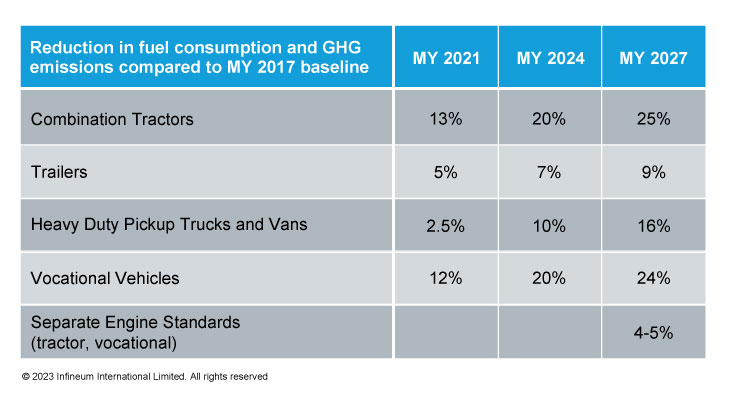
Looking further ahead, EPA has announced a proposal for more stringent GHG standards. It is proposing different CO2 standards for MY 2027 heavy-duty vehicles that, for some vehicle types, go beyond the current Phase 2 standards and progressively lower standards have been proposed through to 2032. However, the limits depend on the type of vehicle.
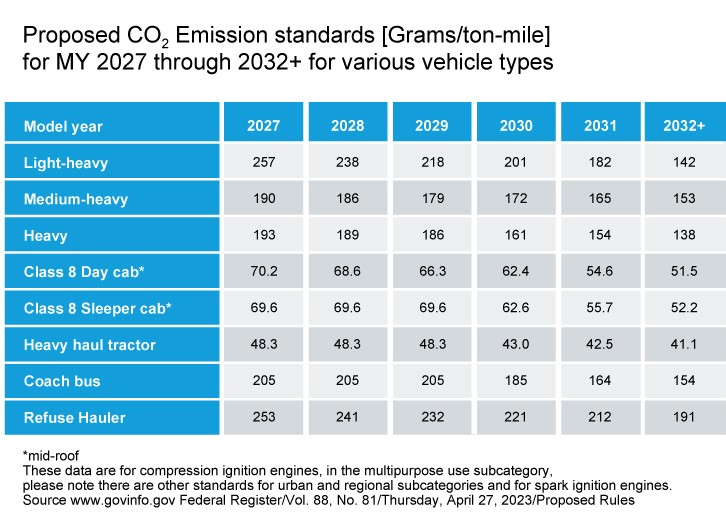
If we look at these reductions in percentage terms from 2027 to 2032 it’s more evident to see the impacts on the various vehicle types.
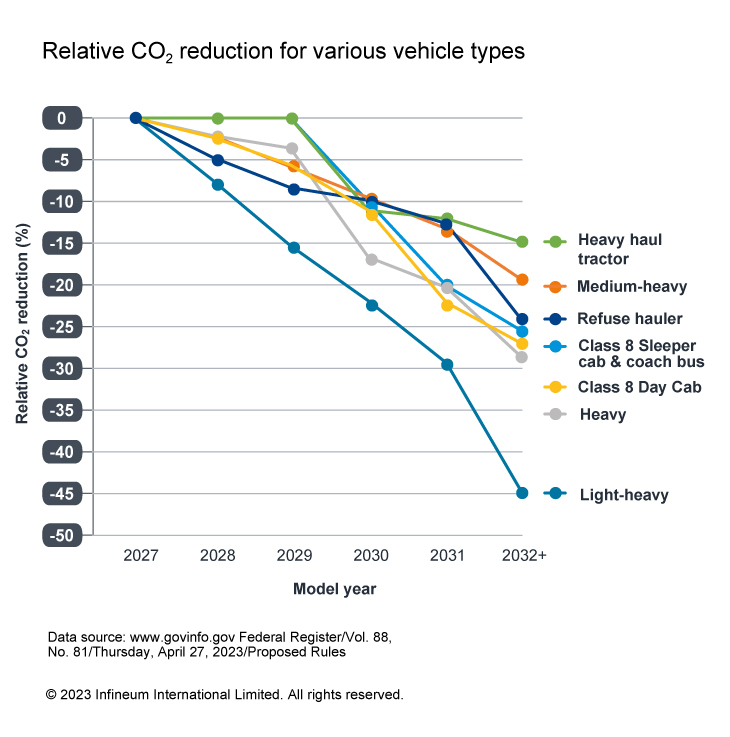
EPA expects the Phase 3 rule to cumulatively reduce tailpipe GHG emissions by 2.3 billion tons over 2027 – 2055. Over 95% of the reductions are associated with CO2 emissions, and the rest with methane and nitrous oxide (N2O) reductions. In addition, reduced fuel consumption will also result in the reduction of other pollutants. In 2055, emissions of NOx are estimated to reduce by 28%, particulate matter (PM2.5) by 39%, volatile organic compounds (VOC) by 37%, and sulphur dioxide (SO2) by 31%.
Phase 3 may look more severe than Phase 2, but it accounts for fleet averages across the different vehicle types and has forecast a slower roll in of battery, fuel cell and hydrogen internal combustion engine (H2ICE) than may happen in the field. In reality, Phase 3 is designed to push the roll over from conventional ICE to alternative vehicle types.
To meet the 2027 challenges, significant heavy-duty diesel engine technology changes can be expected. The request for a new heavy-duty diesel engine oil category development aims to ensure lubricants continue to protect engines and aftertreatment system hardware for longer periods. In addition, as OEMs look for fuel economy improvements the specification will be designed to enable the use of lower viscosity grades while still ensuring hardware protection is maintained.
Work on the new engine oil category is underway and it is expected to deliver improvements in the following areas:
In addition, we can expect the removal of obsolete tests and the introduction of new limits and new tests. The EMA is targeting a First License date of January 1 2027, ready for use in model year 2027 vehicles. There is much development and testing to be done so that engine oils are ready for market in this timeframe.
Sign up to receive monthly updates via email